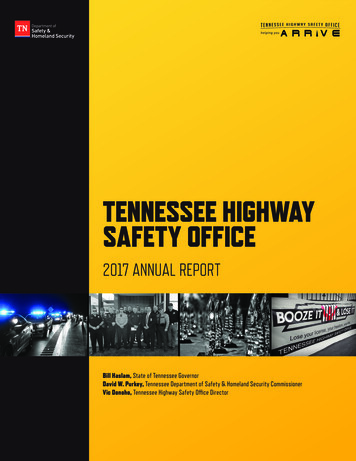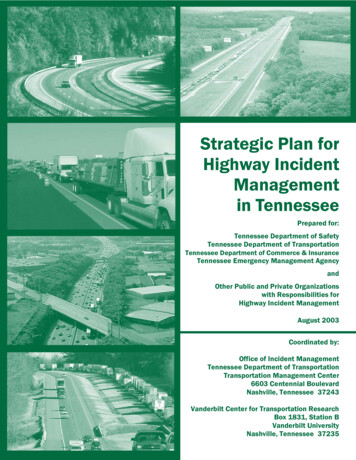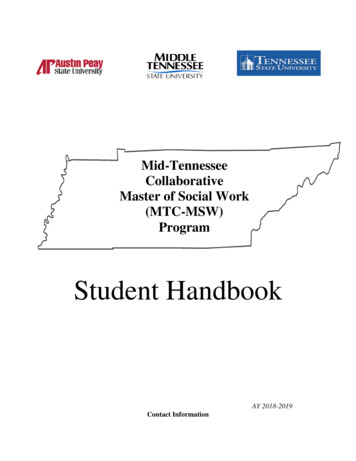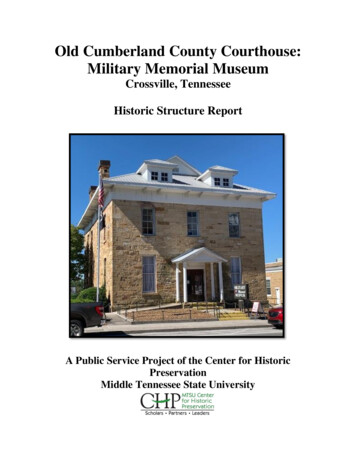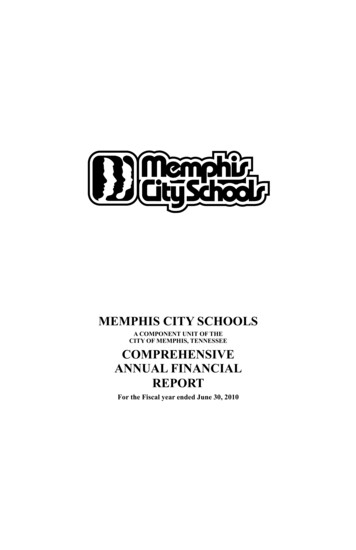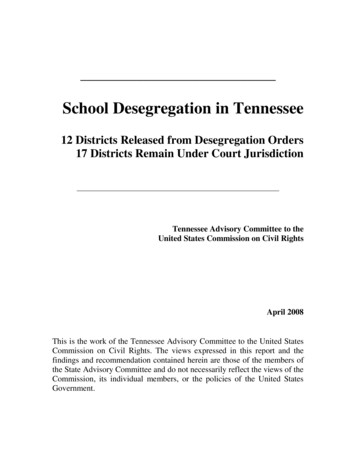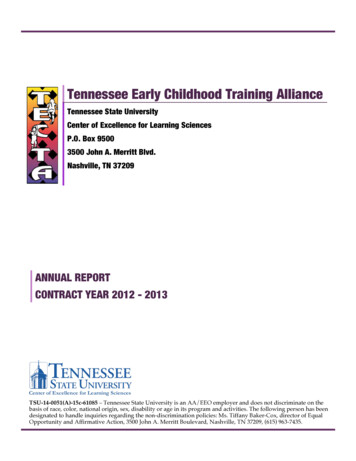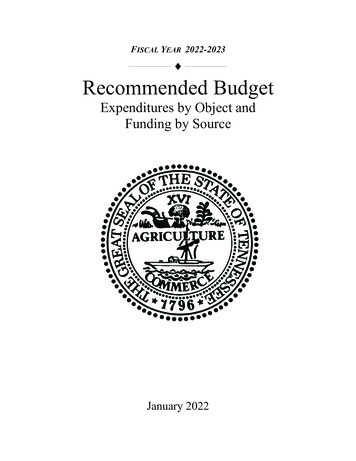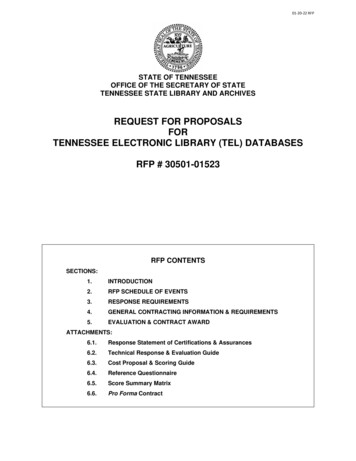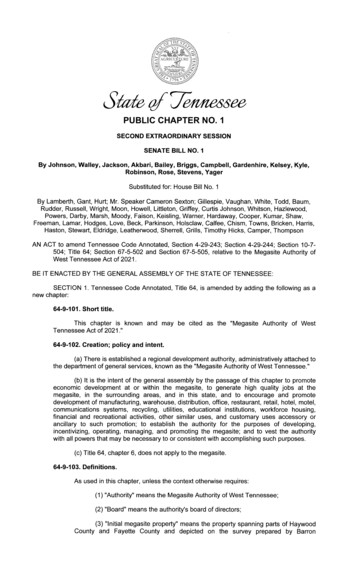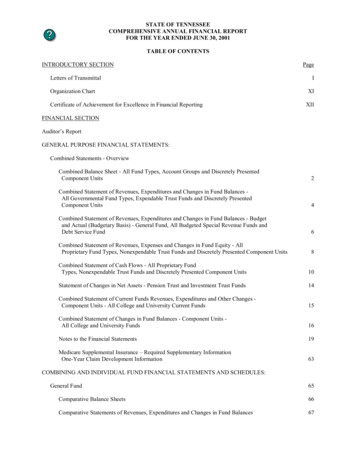
Transcription
STATE OF TENNESSEECOMPREHENSIVE ANNUAL FINANCIAL REPORTFOR THE YEAR ENDED JUNE 30, 2001?TABLE OF CONTENTSINTRODUCTORY SECTIONLetters of TransmittalOrganization ChartCertificate of Achievement for Excellence in Financial ReportingPageIXIXIIFINANCIAL SECTIONAuditor’s ReportGENERAL PURPOSE FINANCIAL STATEMENTS:Combined Statements - OverviewCombined Balance Sheet - All Fund Types, Account Groups and Discretely PresentedComponent Units2Combined Statement of Revenues, Expenditures and Changes in Fund Balances All Governmental Fund Types, Expendable Trust Funds and Discretely PresentedComponent Units4Combined Statement of Revenues, Expenditures and Changes in Fund Balances - Budgetand Actual (Budgetary Basis) - General Fund, All Budgeted Special Revenue Funds andDebt Service Fund6Combined Statement of Revenues, Expenses and Changes in Fund Equity - AllProprietary Fund Types, Nonexpendable Trust Funds and Discretely Presented Component Units8Combined Statement of Cash Flows - All Proprietary FundTypes, Nonexpendable Trust Funds and Discretely Presented Component Units10Statement of Changes in Net Assets - Pension Trust and Investment Trust Funds14Combined Statement of Current Funds Revenues, Expenditures and Other Changes Component Units - All College and University Current Funds15Combined Statement of Changes in Fund Balances - Component Units All College and University Funds16Notes to the Financial Statements19Medicare Supplemental Insurance – Required Supplementary InformationOne-Year Claim Development Information63COMBINING AND INDIVIDUAL FUND FINANCIAL STATEMENTS AND SCHEDULES:General Fund65Comparative Balance Sheets66Comparative Statements of Revenues, Expenditures and Changes in Fund Balances67
PageComparative Schedules of Revenues by Source68Comparative Schedules of Expenditures by Function and Department69Comparative Schedules of Expenditures by Object70Special Revenue Funds72Combining Balance Sheet - All Special Revenue Funds74Combining Statement of Revenues, Expenditures and Changesin Fund Balances - All Special Revenue Funds76Combining Balance Sheet - Other Special Revenue Funds78Combining Statement of Revenues, Expenditures and Changes in Fund Balances Other Special Revenue Funds80Comparative Balance Sheets - Education Fund82Comparative Statements of Revenues, Expenditures and Changes in Fund Balances Education Fund83Comparative Schedules of Expenditures by Object - Education Fund84Comparative Balance Sheets - Highway Fund86Comparative Statements of Revenues, Expenditures and Changes in Fund Balances Highway Fund87Comparative Schedules of Revenues by Source - Highway Fund88Comparative Schedules of Expenditures by Object - Highway Fund89Combining Schedule of Revenues, Expenditures and Changes in FundBalances - Budget and Actual (Budgetary Basis) - All BudgetedSpecial Revenue Fund Types90Combining Schedule of Revenues, Expenditures and Changes in Fund Balances Budget and Actual (Budgetary Basis) - Other Budgeted Special Revenue Fund TypesDebt Service Fund100108Comparative Balance Sheets109Comparative Statements of Revenues, Expenditures and Changes in Fund Balances110Capital Projects Fund111Comparative Balance Sheets112Comparative Statements of Revenues, Expenditures and Changes in Fund Balances112
PageEnterprise Funds113Combining Balance Sheet - Enterprise Funds114Combining Statement of Revenues, Expenses and Changes in Fund Equity Enterprise Funds116Combining Statement of Cash Flows - Enterprise Funds118Internal Service Funds121Combining Balance Sheet - Internal Service Funds122Combining Statement of Revenues, Expenses and Changes in Fund Equity Internal Service Funds124Combining Statement of Cash Flows - Internal Service Funds126Trust and Agency Funds129Combining Balance Sheet - All Trust and Agency Funds130Combining Balance Sheet - Expendable Trust Funds132Combining Statement of Revenues, Expenditures and Changes in Fund Balances Expendable Trust Funds133Combining Balance Sheet - Nonexpendable Trust Funds134Combining Statement of Revenues, Expenses and Changes in Fund Balances Nonexpendable Trust Funds135Combining Statement of Cash Flows - Nonexpendable Trust Funds136Statement of Net Assets - Pension Trust and Investment Trust Funds137Combining Balance Sheet - Agency Funds139Combining Statement of Changes in Assets and Liabilities - All Agency Funds140General Fixed Assets Account Group142Schedule of General Fixed Assets by Source143Schedule of General Fixed Assets by Function and Activity144Schedule of Changes in General Fixed Assets by Function and Activity145
PageGeneral Long-Term Obligations Account Group146Schedule of Changes in General Long-Term Obligations147Component Units148Combining Balance Sheet - Component Units150Combining Statement of Revenues, Expenditures, and Changes in Fund Balances Component Units - All Governmental Fund Types154Combining Statement of Revenues, Expenses, and Changes in Fund Equity Component Units - All Proprietary Fund Types158Combining Statement of Cash Flows - Component Units - All Proprietary Funds160Combining Balance Sheet - Component Units - All College and University Funds162Combining Statement of Current Funds Revenues, Expenditures and Other Changes Component Units - All College and University Current Funds166Combining Statement of Changes in Fund Balances - Component Units All College and University Funds168ScheduleSupplementary SchedulesPage172Debt Service Requirements to Maturity - General Obligation Bonds1173Summary of Debt Service Requirements to Maturity2174Schedule of Outstanding Debt - All Fund Types and Account Groups3175General Obligation Commercial PaperOutstanding-By Purpose - All Fund Types and Account Groups4175Debt Service Requirements to Maturity - Component Units - Revenue Bonds5176Summary of Debt Service Requirements to Maturity - Component Units6178Schedule of Outstanding Debt - Component Units7179
TableSTATISTICAL AND ECONOMIC DATARevenues by Source and Transfers In - All Governmental Fund TypesExpenditures by Function and Transfers Out - All Governmental Fund TypesTax Revenues by Source - All Governmental Fund Types180I181II181III182Description of Tax Sources - All Governmental Fund TypesRatio of Net General Long-Term Debt to Assessed Value and Net Debt Per CapitaComputation of Legal Debt Service MarginRatio of Annual Debt Service for General Long-Term Debt to Total Expenditures - AllGovernmental Fund TypesSchedule of Revenue Bond Coverage - Component Units - Tennessee Housing DevelopmentAgency and College and University FundsSchedule of Fees/Charges, Legislative Appropriations and Debt ServiceEconomic 88Index to Securities and Exchange Commission (SEC) Disclosures194Acknowledgments196
INTRODUCTORY SECTION
STATE OF TENNESSEEDEPARTMENT OF FINANCE AND ADMINISTRATIONSTATE CAPITOLNASHVILLE, TENNESSEE 37243-0285C. WARREN NEEL, Ph.D.COMMISSIONERDecember 4, 2001The Honorable Don SundquistGovernor of the State of TennesseeI am pleased to submit the Comprehensive Annual Financial Report of the State of Tennessee for the fiscal yearended June 30, 2001. Responsibility for both the accuracy of the data and the completeness and fairness of thepresentation, including all disclosures, rests with the state. To the best of our knowledge and belief, the encloseddata are accurate in all material respects and are reported in a manner designed to present fairly the financial positionand results of operations of the various funds and account groups of the state. All disclosures necessary to enable thereader to gain an understanding of the state’s financial activities have been included.The Comprehensive Annual Financial Report is presented in three sections: introductory, financial and statistical.The introductory section includes this transmittal letter and the state’s organizational chart. The financial sectionincludes the general-purpose financial statements and the combining and individual fund and account group financialstatements and schedules, as well as the auditor’s report on the general-purpose financial statements. The statisticalsection includes selected financial and demographic information, generally presented on a multi-year basis.The financial reporting entity of the state includes all the funds and account groups of the primary government aswell as all its component units. Component units are legally separate entities for which the primary government isfinancially accountable. The government provides a full range of services including education, health and socialservices, transportation, law, correction, safety, resources and regulation, and business and economic development.ECONOMIC CONDITION AND OUTLOOKThe state’s economic diversity has improved substantially over the last several years. Investments announced in newand expanding manufacturing businesses exceeded one billion dollars every year since 1983, and exceeded threebillion dollars in the last three years. Announced manufacturing capital investments in 2000 were 4.95 billion.This growth has created 27,013 new jobs in this year alone, and has had a positive effect on employment and thestate’s economy. Additionally, investments in headquarters, distribution and selected services grew to 2.1 billion in2000 and created 14,670 new jobs. For June 2001, the state unemployment rate of 4.5% was under the nationalaverage of 4.7%. The financial impact of these events is presented later in this letter. Based on current projections,the state’s overall growth is expected to exceed the national average over the next several years. While having apositive impact, this growth also presents significant challenges for the state. If the present level of services is to bemaintained and an ambitious program for major improvements in the educational system is to continue to beimplemented, the state must continue to conservatively manage its financial resources.The impressive U.S. economic expansion of the 1990's has ended with the U.S. in a recessionary period. Asevidence, the real (inflation-adjusted) gross domestic product increased only .3 percent during the second quarter ofcalendar year 2001 and decreased .4 percent during the third quarter of 2001. Inflation concerns have given way toconcerns about a recession, accordingly the Federal Reserve has sharply reduced interest rates in recent months.Tennessee’s state government will take appropriate steps to ensure that the state is able to successfully manage itsfinances in the future.
MAJOR INITIATIVESFor the year. The Administration produced a budget to fund the daily operations of state government along withsome improvements for education, higher education, TennCare, and an increase in the Revenue Fluctuation Reserve.The budget also presented associated tax legislation to provide sources necessary to fund Tennessee’s stategovernment. The Legislature deliberated over the proposed budget until the end of the fiscal year, passing anappropriations act on June 29, 2001. The Legislature then reconvened in July 2001, and passed a secondappropriations act that amended the one previously passed. The amended act had no new taxes and continued to usenon-recurring revenues to fund the daily state operations. The Governor vetoed the bill, but the Legislature overrodehis veto. As a result, all three of the state’s credit rating agencies downgraded the state’s credit rating to AA.Standard and Poor’s has also given the state’s credit rating a negative outlook. The Administration will continue todevelop a balanced budget to address the state’s programmatic needs.The Administration continues its strategic planning process that it began in 1997. The planning update processidentified issues of focus for the remainder of the Sundquist Administration. Executive branch departmental plansalign with the statewide plan and become the foundation for the departmental budget requests and assist inprioritizing information systems development projects.One of the Administration’s goals is excellence in education. The Gateway testing program was finalized this year.This program tests high school students’ proficiency in reading, math and science. The Governor’s reading initiativestarted with the development of a training component for approximately 60 schools. Accountability is beingaddressed as a part of the drive for excellence. Forty-eight low performing schools were identified. The Departmentof Education provided recently retired exemplary educators to the schools to assist them in analyzing areas forimprovements. Ninety-eight schools were put on notice that their results were not meeting standards.Another Administration goal involved economic opportunity. The Department of Transportation continued with itsplans to preserve existing infrastructure, connect rural county seats to the interstate highway system, and relieveurban congestion. Also, TDOT is assisting the Department of Finance and Administration in the state’simplementation of GASB 34 in using the modified approach for reporting infrastructure beginning with the financialstatements for the period ending June 30, 2002. Providing a structure for condition assessments and the evaluationof those assessments should allow more accountability for the use of highway funds and the prioritization of futureneeds to maintain the state’s infrastructure.Having a responsible and accountable government is another of the Administration’s goals. Elements of aresponsible and accountable government include becoming more customer-focused and improving processes throughthe use of technology. Part of this initiative included the installation of a government portal that provides onlineservices to citizens. The state’s portal was developed in partnership with an experienced e-government solutionsprovider, National Information Consortium (NIC). The portal, www.TennesseeAnytime.org, has several applicationsdesigned to improve responsiveness to citizens. By making more services and records available online, the state willbe creating a more efficient and effective state government that is available to citizens and businesses around theclock, every day. The first application unveiled on the website was a drivers license renewal application. Updates toaddresses can also be made online. Another portal application provides TennCare eligibility verification to ourhealthcare providers, speeding up their filing process dramatically. Each month the portal activity continues to grow.The applications that are being developed will help citizens and businesses interact with state government.During the past year, the success of TennesseeAnytime has been recognized on a national level. In September of thisyear, the state received word that TennesseeAnytime had been selected as a finalist in the Best of the Web awardsponsored by the Center for Digital Government. In addition, a Brown University report detailed Tennessee’sdramatic improvement in “E-government”, noting it was the most improved in the nation. During the past year,Tennessee climbed from 28th to fourth in a rating of all states e-government capability.Another use of technology that improves the effectiveness of government is the development of a financial datawarehouse. The Department of Finance and Administration built a financial data warehouse to improve the reportingand analysis of the state’s financial information. Revenue and expenditure information has been loaded and is beingsuccessfully summarized and retrieved via the web-based system. The project is beginning its third phase ofdevelopment by adding more financial information to the warehouse. Subsequent phases will add more data thatmanagers need to make informed decisions.
Due to events of September 11, 2001, the Governor has established an Office of Homeland Security. Despite thestate’s budget problems, the Governor has provided more than 8 million in additional resources for the Departmentsof Agriculture, Commerce and Insurance, General Services, Health, Safety and Veteran’s Affairs. These additionalresources will assist these agencies in increasing lab-testing capabilities, security and providing additional equipmentand training.For the Future: Work will continue on these strategic initiatives through the end of the Administration. Theinitiatives reflect the issues facing Tennessee today.Departmental Focus. Technology has been a driving force behind recent changes within the Tennessee Departmentof Safety (TDOS).The Department is comprised of almost 1,900 employees who deliver a wide range of services to the public.Directed by Safety Commissioner Mike Greene, TDOS includes the Tennessee Highway Patrol, Commercial VehicleEnforcement, Capitol Police, Driver License Issuance, Title and Registration, and several other divisions.One of the most exciting programs is the department’s online driver license and change of address application. Theapplication debuted in October of 2000, when Governor Don Sundquist became the first Tennessean to renew adriver license online.He wasn’t the last. Between October 2000 and October 2001, a total of 26,414 Tennessee drivers renewed theirlicenses online. Almost 24,000 used the application to register a change of address with the Department of Safety.The renewal application was the State of Tennessee’s first online government service offering, and dozens of otherservices quickly followed at a redesigned services and information portal, TennesseeAnytime.org. The growing listof services reflects the state’s continued efforts to offer the best in e-government to its citizens.Following the introduction of the renewal application, the Department made motor vehicle reports (driving records)available via the Internet in February of this year. Currently, the Department processes requests from companies thathave contracted with the state portal provider to access the records. Plans are being made to allow individuals toobtain their records online.Other technology projects underway at Safety include:1.An Integrated Voice Response (IVR) System was made available to the public in April of this year. Thenew system, like the old telephone system, allows customers to obtain general information regarding theDepartment’s services. The IVR goes a step further by allowing the individual to enter a driver licensenumber and receive individualized information about the status of their license or requirements needed inorder to reinstate their driving privileges if their license is revoked or suspended. The telephone systemgathers the information from the state’s driver license database.The customer can listen to therequirements, have them mailed or faxed, or to speak to a driver license examiner if needed.2.TRUST (Title and Registration User System of Tennessee) will utilize the latest state of the art technologiesand techniques. The system is based on internet browser technology, centralized relational databases aswell as local synchronized databases. The project encompasses all of Tennessee’s 95 counties, linking themtogether with a network that will guarantee bandwidth to meet the needs of the transaction load andavailable 99.7 percent of the time. All archive documents will be imaged at county clerk offices and storedon a central servicer with instant access. Internet XML technology will be utilized to move data betweenthe counties and the state, between auto dealers and the county clerks, and between lending institutions andthe state.3.The Driver License Mobile Roving Crew project incorporates a mobile unit equipped with a completedriver license issuance center capability. The unit is wired with a local area network supporting six workstations, has flat screen single unit computers, a Polaroid digital imaging center, an eye test center, and twoexam test centers. The mobile unit is equipped with wireless network capability and mobile satellitenetwork capability. Phase one of the project will incorporate technology to support the staff in 12 fixedparking locations, and phase two will allow the unit to function anywhere in the state.
4.The Driver License Digitized Project is set to get underway in the next few months. This project takesTennessee to the next level with smart card documents. The new driver license will incorporate the latesttechnology in 2D bar coding. The bar code will contain the demographic information about the holder, adigital copy of the photo, and it has the capability of holding fingerprints for handgun permits.5.Commercial Vehicle Information System Network project is underway, and will allow Commercial VehicleEnforcement (CVE) officers to inspect a truck at the roadside with database links to all required commercialsafety systems. The project, a first in Tennessee, requires putting mobile computers in each CVE patrol car.In the long term, the Department will build a wireless data/radio network to support the CVE vehicles withsatellite network link on each CVE vehicle to support data communications. Officers will be able to fill outinspection forms, issue electronic citations on their car computers; and instantly transmit data to state andnational databases. The applications utilized in this project are the result of a joint venture with more than28 other states, thus standardizing a national approach to commercial vehicle management and control.6.The Accident Reporting project has received grants from the Governor’s Highway Safety Office which willbe used to build a new accident reporting system that will include a document scanner and a centraldatabase that can be accessed via both the intranet and internet. This system will incorporate a new smartform that eliminates the need for backroom coding, and will eliminate the need to outsource the forms to bekeyed. With scanable forms, the officers can simply check the appropriate categories on the form, and thusforms can then be scanned resulting in 70 percent of the accident information being extracted and leavingonly 30 percent to be keyed at the Department of Safety. The one-year backlogs on processing accidentinformation will be reduced to within one working month. The local jurisdictions that already haveautomated systems will be able to transmit their data to the new accident system. Local police jurisdictionswill be able to log in to the accident system server, obtain detailed reports of accidents they have worked,and pull up image copies of their accidents for download or print.Technology improvements continue to take place in every area of business through the Department of Safety. Theseefforts greatly improve the quality of data and timeliness of posting activity. The Department’s goal is to move all ofits data input processes to the points of service. As its service providers meet the citizens, they can capture andprocess all the needed information for the appointed function. This type of automation reduces data input processes,thus freeing up more staff to actually serve the public instead of serving the paperwork.FINANCIAL INFORMATIONIn developing and modifying the state’s accounting system, consideration is given to the adequacy of internalaccounting controls. Internal accounting controls are designed to provide reasonable, but not absolute, assuranceregarding the safeguarding of assets against loss from unauthorized use or disposition and the reliability of financialrecords for preparing financial statements and maintaining accountability for assets. The concept of reasonableassurance recognizes that the cost of a control should not exceed the benefits likely to be derived, and the evaluationsoccur within the above framework. I believe that the state’s internal accounting controls adequately safeguard assetsand provide reasonable assurance of proper recording of financial transactions.Budgeting Controls. In addition to internal controls, the state maintains budgetary controls. The objective of thesebudgetary controls is to ensure compliance with legal provisions embodied in the annually appropriated budgetapproved by the legislature. Activities of the general fund, special revenue funds (except the Supreme Court Boards,Fraud and Economic Crime and the Dairy Promotion Board, accounted for as special revenue funds) and debtservice fund are included in the annually appropriated budget. Budgetary control is maintained at the departmentallevel by the encumbrance of estimated purchase amounts prior to the release of purchase orders to vendors.Purchase orders, which result in an overrun of available balances, are not released until budget revisions areapproved or additional appropriations are made. Open encumbrances are reported as reservations of fund balance atJune 30, 2001.
General Governmental Functions. General governmental functions are accounted for in four governmental funds the General, Special Revenue, Debt Service and Capital Projects funds. Revenues for general governmentalfunctions totaled 16.7 billion in 2001. Taxes represented 48.5% of general revenues; it is a decrease of 2.6% in thepercentage of the total funding over the prior year from 51.1% to 48.5%. The amount of revenues from varioussources and the changes from last year are shown below (expressed in thousands).Revenue SourceTaxesLicenses, fines, fees and permitsInterest on investmentsFederalDepartmental ServicesOtherAmountPercentof TotalIncrease(Decrease)from 2000 5%1.3.637.010.52.1 115,34419,26338,308646,773235,6823,846 16,717,143100% 1,059,216Percentof Increase(Decrease)1.4%9.471.211.715.61.1The 9.4% increase in license, fines, fees and permits is primarily due to an increase in collections of 9.9 million forthe regulatory fee collected for enhanced emergency 911 services.Interest on investments increased by 38.3 million because more cash was available to invest.Federal revenue for TennCare increased by some 588.6 million.Departmental services increased 64 million for child support collections and 91.6 million for drug rebatecollections for TennCare.
entalfundtyperevenues:REVENUES BY SOURCETAXES48.5%INTEREST ONINVESTMENTSAND OTHER2.7%DEPARTMENTAL SERVICES10.5%LICENSES FINES, FEES ANDFEDERALPERMITS37.0%1.3%
Expenditures for general governmental purposes totaled 15.5 billion in 2001, a 9.6% increase over the previousyear. Changes in expenditures by function from 2000 levels are presented in the following tabulation (expressed inthousands).FunctionAmountGeneral government 349,278Education3,059,538Health and social services8,641,777Law, Justice and public safety897,805Recreation and resources development419,423Regulation of business and professions57,988Transportation1,269,773State shared taxes paid tolocal governments681,151Debt service122,221Capital outlay55,679 15,554,633Percentof crease)from 2000 162(1,562)(15,187) 1,359,003Percentof .3)(21.4)Health and Social Services increased due to increased expenditures of 957.8 million in the TennCare program.Regulation of Business and Professions increased due to increased expenditures of 5.1 million for enhancedemergency 911 services.Capital Outlay decreased 21.4% because fewer projects are being approved by the State Building Commission andcertain large projects were completed in 2000.
Presented below is a chart depicting the uses of governmental fund type expenditures by function:EXPENDITURES BY FUNCTIONLAW, JUSTICE AND PUBLICSAFETY5.8%TRANSPORTATION8.2%DEBT SERVICE AND CAPITALOUTLAY1.1%STATE SHARED TAXES PAID TOLOCAL GOVERNMENTS4.4%GENERAL GOVERNMENT ANDOTHER5.3%HEALTH AND SOCIALSERVICES55.5%EDUCATION19.7%
Presented below are tables depicting revenues and expenditures for the last five years on a current dollar andconstant dollar basis. In addition, a chart showing per capita expenditures on a current and constant dollar basis ispresented.19971998199920002001CURRENT DOLLARS 12,671 13,383 14,100 15,658 16,717CONSTANT DOLLARS 7,905 8,210 8,484 9,082 9,392PERCENT INCREASEOVER PRIOR YEARIN CURRENTDOLLARS3.7%5.6%5.4%11.0%6.8%PERCENT INCREASEOVER PRIOR YEARIN CONSTANTDOLLARS1.4%3.9%3.3%7.1%3.4%
19971998199920002001CURRENT DOLLARS 2,152 2,240 2,319 2,531 2,599CONSTANT DOLLARS 1,342 1,374 1,395 1,468 1,460PERCENT INCREASEOVER PRIOR YEAR INCURRENT DOLLARS0.7%4.1%3.5%9.1%2.7%PERCENT INCREASEOVER PRIOR YEAR INCONSTANT DOLLARS-1.6%2.4%1.5%5.2%-0.5%
19971998199920002001CURRENT DOLLARS 11,599 12,246 13,067 14,196 15,555CONSTANT DOLLARS 7,236 7,513 7,862 8,234 8,739PERCENT INCREASEOVER PRIOR YEAR INCURRENT DOLLARS2.3%5.6%6.7%8.6%9.6%PERCENT INCREASEOVER PRIOR YEAR INCONSTANT DOLLARS0.0%3.8%4.6%4.7%6.1%
General Fund Balance. The fund balance of the general fund increased by 53.4 million in 2001. Of this increase, 153 million was because of the tobacco settlement.Proprietary Funds. Combined operating results for the state’s enterprise funds remained strong in 2001 and werepaced by the insurance activities for local government and local government teacher employees. Operating revenueswere 263.9 million, an increase of 82.0 million over 2000. Operating expenses increased to 268.7 million from 169.3 million, an increase of 99.4 million.Combined operating results for the state’s internal service funds also remained strong in 2001. Operating revenuesand expenses for these cost-reimbursement agencies aggregated 612.4 million and 652.0 million, respectively, ascompared to 2000 amounts of 526.3 million and 540.9 million. The principal internal service operations providedata processing services, third party liability claims processing, agency housing, and employee group insurance.Pension Plan. Total assets of the state’s pension trust fund reached 24.5 billion at June 30, 2001. The net assetsheld in trust for pension benefits total 23.7 billi
Combined Balance Sheet - All Fund Types, Account Groups and Discretely Presented . Medicare Supplemental Insurance - Required Supplementary Information . As a result, all three of the state's credit rating agencies downgraded the state's credit rating to AA. Standard and Poor's has also given the state's credit rating a negative .
